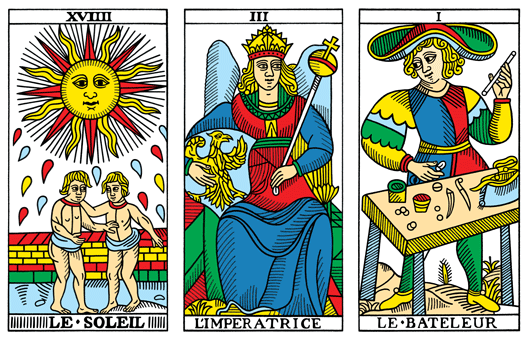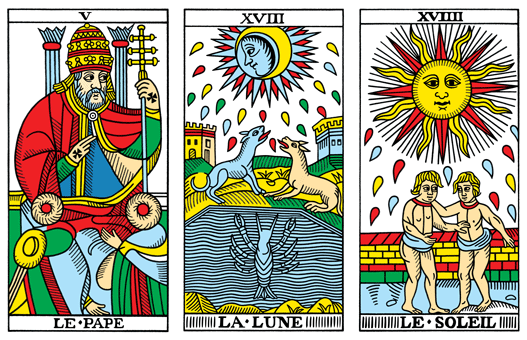Here are some examples of the basic three card spread and its interpretation in the open reading approach. Of course, the story given here is not the only possible way of reading each card combination. It may be a good exercise to look at the spreads yourself, and to give them alternative interpretations of your own.

The Empress figure at the center may be a married woman, whose children appear in the left-hand card. The sun above them can represent the father of the family: leading and providing, but also “in the sky” – that is, remote and not really accessible. Maybe he is too busy with his career or other occupations, and doesn’t find the time and energy to invest in a close emotional contact with his wife and children.
A young man now appears in her life, represented by The Magician at the right. He is light-spirited and avoids commitment, as the fanc clothing and the legs spread to both sides indicate. But as an illusion-weaving showman he may also have personal charm and courting tricks. His stare at her body indicates that he is interested in a sexual relationship with her.
The sitting position in the well-protected chair shows that at this stage, she remains loyal to the family framework. She embraces the eagle coat-of-arm which is a symbol of the royal family, and holds her scepter as a barrier in front of the new man’s face. But her eyes directed towards him indicate that the attraction is mutual, and the white scepter handle based on her pelvis can suggest an open way in which her desire can move forward. We can conclude that if the woman’s husband doesn’t wake up to give her more attention, it is likely that sooner or later, she will succumb to the young man’s advances.

The Pope in the left-hand card can represent a teacher or a father, and the two small figures seen from behind may be two students or children. His attention isn’t divided equally between them, and it seems as if it is more oriented towards the one on the right. Perhaps one of the brothers feels rejected, not getting as much of their father’s attention as his brother.
In the upper part of the middle card we see the moon replacing the Pope. Maybe the father figure has died and now he is “in heaven”. In his absence, strong animal-like emotions of jealousy and mutual resentment arise between the brothers, represented by the two dogs barking at each other. The crab at the bottom of the card can indicate deep and dark feelings rising to the surface. The moon face looking towards the first card can indicate that the present relationship is still motivated by past emotions.
The card on the right can be seen as a reparation of the fraternal relationship. The two figures are once again human. Their mutual touch expresses warmth and trust, and the mythological father figure in the sky is shining light equally on both of them. It is as though they have overcome their jealousy and the old competition for the deceased father’s attention, understanding that both did in fact benefit from it.
The following story appeared some years ago on an internet Tarot forum. A woman who described herself as a devoted employee in a big organization found herself the object of her immediate boss’ attentions. He was a married man and she had no romantic interest in him. She felt confused, blamed herself for the situation, and wondered whether she should give in to his advances or look for another job. In her distress she drew three cards and asked the forum members for advice.

This is not a usual reading situation. But looking at The World card in the center, and in spite of her own subjective feeling of helplessness, I could see her as the active figure in the spread. The dancing posture indicated that even within the limited space available to her, she can still find freedom to maneuver. As to the two objects in her hands, these may represent two options that she can put in front of her boss.
The Judgment card on the left, with a trumpet whose sound is heard far and wide, represents one option. The central figure seen from the back is rising from a hole in the ground, possibly indicating hidden things being revealed in broad daylight. The dramatic character of the card shows what will happen if she chooses this option: to blow the whistle and make a public scandal. It would surely hurt him and possibly ruin his career.
The other option is represented by the card on the right with a solid and regular pattern of coins, possibly representing the ongoing routine of a workplace. The pairs of coins layered on top of each other may also symbolize an office building, or simply the orderly structure of management and subordination in a big organization. In this option everything returns to normal: no more harassment, no ruining of career and personal life, everyone goes back to work as if nothing ever happened.
My advice was that she let him realize this perspective, not by making an explicit menace but by giving a clear hint that now it is she who has power over him. His own fears would do the rest, and make him go for the second option. As the querent later wrote in the same forum, this is exactly what happened.
……..
(more examples in the book)